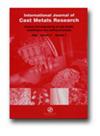挤压铸造铝硅活塞合金的拉伸断裂特征
IF 1.1
4区 材料科学
Q3 METALLURGY & METALLURGICAL ENGINEERING
International Journal of Cast Metals Research
Pub Date : 2021-02-25
DOI:10.1080/13640461.2021.1889163
引用次数: 2
摘要
目前,挤压铸造被认为是开发高质量活塞部件的一种方便的工艺。本文采用挤压铸造和压铸等铸造方法,从铸造和热处理两方面对铝硅活塞的拉伸性能进行了比较。采用k -最近邻(KNN)算法预测挤压铸造铝硅合金的拉伸断裂。在MATLAB平台上实现了该方法,并将铸件的拉伸断口与实验值和预测值进行了比较。采用扫描电镜对材料进行了显微组织性能分析和断口分析。铸态和热处理试样的最大抗拉强度分别为184 MPa和297 MPa。结果表明,与人工神经网络相比,该方法是预测铝硅合金材料拉伸断裂的有效方法。本文章由计算机程序翻译,如有差异,请以英文原文为准。
Characterisation of tensile fracture in squeeze casted Al–Si piston alloy
ABSTRACT Nowadays, Squeeze casting is considered as a convenient process for developing quality piston components. In this paper, casting methods such as squeeze casting and die casting techniques are used for compare the tensile behavior of Al-Si piston in the view of casted and heat-treated aspects. K-Nearest Neighbour (KNN) algorithm is used for predicting the tensile fracture of the squeeze casted Al-Si alloy. The proposed method is implemented in the MATLAB platform, and the tensile fracture in casting is compared with the experimental and predicted value. The scanning electron microscope analyzes the microstructural property and fractures analysis of the material. The maximum ultimate tensile strength of the casted and heat-treated specimen is 184 MPa and 297 MPa. The results indicate the proposed approach is an efficient method than the implemented Artificial neural network for predicting the tensile fracture in Aluminium-Silicon alloy materials.
求助全文
通过发布文献求助,成功后即可免费获取论文全文。
去求助
来源期刊
CiteScore
2.70
自引率
7.10%
发文量
14
审稿时长
7.5 months
期刊介绍:
The International Journal of Cast Metals Research is devoted to the dissemination of peer reviewed information on the science and engineering of cast metals, solidification and casting processes. Assured production of high integrity castings requires an integrated approach that optimises casting, mould and gating design; mould materials and binders; alloy composition and microstructure; metal melting, modification and handling; dimensional control; and finishing and post-treatment of the casting. The Journal reports advances in both the fundamental science and materials and production engineering contributing to the successful manufacture of fit for purpose castings.

 求助内容:
求助内容: 应助结果提醒方式:
应助结果提醒方式:


